Ice Nucleation Properties of Ice-binding Proteins from Snow Fleas
Abstract
:1. Introduction
2. Methods
2.1. Sample Collection and Preparation
2.2. Species Identification
2.3. Morphological Analysis Using Cryogenic Scanning Electron Microscopy, Cryo-SEM
2.4. Centrifugal Filtration
2.5. Ice-Affinity Purification
2.6. Sodium Dodecyl Sulfate-Polyacrylamide Gel Electrophoresis (SDS-PAGE), Mass Spectrometry, and Protein Concentration Determination
2.7. Infrared Spectroscopy
2.8. Secondary Structure Estimation
2.9. Thermal Hysteresis Activity Measurement
2.10. Ice Nucleation Measurement
2.11. Ice Nucleation Analysis
3. Results
3.1. Gene Barcoding
3.2. Morphological Analysis
3.3. Separation of Protein Based on Molecular Weight
3.4. Analysis of Protein Secondary Structure
3.4.1. Fourier-transform infrared spectroscopy (FTIR) Analysis
3.4.2. Circular dichroism (CD) Spectroscopy Analysis
3.5. Measurement of Thermal Hysteresis (TH)
3.6. Ice Nucleation Activity
4. Discussion
5. Conclusions
Supplementary Materials
Author Contributions
Funding
Acknowledgments
Conflicts of Interest
References
- Deharveng, L.; D’Haese, C.A.; Bedos, A. Global diversity of springtails (Collembola; Hexapoda) in freshwater. In Freshwater Animal Diversity Assessment; Balian, E.V., Lévêque, C., Segers, H., Martens, K., Eds.; Springer: Dordrecht, The Netherlands, 2008; pp. 329–338. ISBN 978-1-4020-8258-0. [Google Scholar]
- Gruia, M.; Poliakov, D.; Broza, M. Collembola of Northern Israel, II (Special Papers in Honor of late Professor Ryozo Yoshii). Contrib. Biol. Lab. Kyoto Univ. 2000, 29, 117–131. [Google Scholar]
- Palissa, A. Beiträge zur Collembolenfauna Israels. Beiträge Entomol. Contrib. Entomol. 2006. [Google Scholar] [CrossRef]
- Montiel, P.O.; Grubor-Lajsic, G.; Worland, M.R. Partial desiccation induced by sub-zero temperatures as a component of the survival strategy of the Arctic collembolan Onychiurus arcticus (Tullberg). J. Insect Physiol. 1998, 44, 211–219. [Google Scholar] [PubMed]
- Clark, M.S.; Thorne, M.A.; Purać, J.; Burns, G.; Hillyard, G.; Popović, Z.D.; Grubor-Lajsić, G.; Worland, M.R. Surviving the cold: Molecular analyses of insect cryoprotective dehydration in the Arctic springtail Megaphorura arctica (Tullberg). BMC Genom. 2009, 10, 328. [Google Scholar] [CrossRef]
- Lin, F.-H.; Graham, L.A.; Campbell, R.L.; Davies, P.L. Structural modeling of snow flea antifreeze protein. Biophys. J. 2007, 92, 1717–1723. [Google Scholar] [CrossRef]
- Graham, L.A.; Davies, P.L. Glycine-rich antifreeze proteins from snow fleas. Science 2005, 310, 461. [Google Scholar] [CrossRef]
- Braslavsky, I.; Drori, R. LabVIEW-operated novel nanoliter osmometer for ice binding protein investigations. J. Vis. Exp. 2013, e4189. [Google Scholar] [CrossRef]
- Duman, J.G. Antifreeze and ice nucleator proteins in terrestrial arthropods. Annu. Rev. Physiol. 2001, 63, 327–357. [Google Scholar] [CrossRef]
- Worland, M.R.; Block, W. Desiccation stress at sub-zero temperatures in polar terrestrial arthropods. J. Insect Physiol. 2003, 49, 193–203. [Google Scholar] [CrossRef]
- Elnitsky, M.A.; Hayward, S.A.L.; Rinehart, J.P.; Denlinger, D.L.; Lee, R.E. Cryoprotective dehydration and the resistance to inoculative freezing in the Antarctic midge, Belgica antarctica. J. Exp. Biol. 2008, 211, 524–530. [Google Scholar] [CrossRef] [PubMed]
- Block, W.; Worland, M.R. Experimental studies of ice nucleation in an Antarctic springtail (Collembola, Isotomidae). Cryobiology 2001, 42, 170–181. [Google Scholar] [CrossRef] [PubMed]
- Eickhoff, L.; Dreischmeier, K.; Zipori, A.; Sirotinskaya, V.; Adar, C.; Reicher, N.; Braslavsky, I.; Rudich, Y.; Koop, T. Contrasting behavior of antifreeze proteins: Ice growth inhibitors and ice nucleation promoters. J. Phys. Chem. Lett. 2019, 10, 966–972. [Google Scholar] [CrossRef] [PubMed]
- Hosoishi, S.; Ogata, K. Description and DNA barcoding of Crematogaster fraxatrix Forel, 1911 and two new closely related species from Cambodia and Indonesia (Hymenoptera, Formicidae). Zookeys 2014, 57–68. [Google Scholar] [CrossRef] [PubMed]
- Benson, D.A.; Cavanaugh, M.; Clark, K.; Karsch-Mizrachi, I.; Ostell, J.; Pruitt, K.D.; Sayers, E.W. GenBank. Nucleic Acids Res. 2018, 46, D41–D47. [Google Scholar] [CrossRef] [PubMed]
- Ratnasingham, S.; Hebert, P.D.N. bold: The Barcode of Life Data System (http://www.barcodinglife.org). Mol. Ecol. Notes 2007, 7, 355–364. [Google Scholar] [CrossRef] [PubMed]
- FigTree. Available online: http://tree.bio.ed.ac.uk/software/figtree/ (accessed on 1 September 2019).
- Biggs, C.I.; Bailey, T.L.; Graham, B.; Stubbs, C.; Fayter, A.; Gibson, M.I. Polymer mimics of biomacromolecular antifreezes. Nat. Commun. 2017, 8, 1546. [Google Scholar] [CrossRef]
- Marshall, C.J.; Basu, K.; Davies, P.L. Ice-shell purification of ice-binding proteins. Cryobiology 2016, 72, 258–263. [Google Scholar] [CrossRef]
- Adar, C.; Sirotinskaya, V.; Bar Dolev, M.; Friehmann, T.; Braslavsky, I. Falling water ice affinity purification of ice-binding proteins. Sci. Rep. 2018, 8, 11046. [Google Scholar] [CrossRef] [Green Version]
- Sullivan, S.T.; Tang, C.; Kennedy, A.; Talwar, S.; Khan, S.A. Electrospinning and heat treatment of whey protein nanofibers. Food Hydrocoll. 2014, 35, 36–50. [Google Scholar] [CrossRef]
- Dreischmeier, K.; Budke, C.; Wiehemeier, L.; Kottke, T.; Koop, T. Boreal pollen contain ice-nucleating as well as ice-binding “antifreeze” polysaccharides. Sci. Rep. 2017, 7, 41890. [Google Scholar] [CrossRef]
- Johnson, W.C. Analyzing protein circular dichroism spectra for accurate secondary structures. Proteins 1999, 35, 307–312. [Google Scholar] [CrossRef]
- Whitmore, L.; Wallace, B.A. Protein secondary structure analyses from circular dichroism spectroscopy: Methods and reference databases. Biopolymers 2008, 89, 392–400. [Google Scholar] [CrossRef] [PubMed]
- Reicher, N.; Segev, L.; Rudich, Y. The WeIzmann Supercooled Droplets Observation on a Microarray (WISDOM) and application for ambient dust. Atmos. Meas. Tech. 2018, 11, 233–248. [Google Scholar] [CrossRef] [Green Version]
- Reicher, N.; Budke, C.; Eickhoff, L.; Raveh-Rubin, S.; Kaplan-Ashiri, I.; Koop, T.; Rudich, Y. Size-dependent ice nucleation by airborne particles during dust events in the eastern Mediterranean. Atmos. Chem. Phys. 2019, 19, 11143–11158. [Google Scholar] [CrossRef] [Green Version]
- Koop, T.; Zobrist, B. Parameterizations for ice nucleation in biological and atmospheric systems. Phys. Chem. Chem. Phys. 2009, 11, 10839–10850. [Google Scholar] [CrossRef] [PubMed]
- Attard, E.; Yang, H.; Delort, A.M.; Amato, P.; Pöschl, U.; Glaux, C.; Koop, T.; Morris, C.E. Effects of atmospheric conditions on ice nucleation activity of Pseudomonas. Atmos. Chem. Phys. 2012, 12, 10667–10677. [Google Scholar] [CrossRef]
- Mok, Y.-F.; Lin, F.-H.; Graham, L.A.; Celik, Y.; Braslavsky, I.; Davies, P.L. Structural basis for the superior activity of the large isoform of snow flea antifreeze protein. Biochemistry 2010, 49, 2593–2603. [Google Scholar] [CrossRef]
- Pentelute, B.L.; Gates, Z.P.; Tereshko, V.; Dashnau, J.L.; Vanderkooi, J.M.; Kossiakoff, A.A.; Kent, S.B.H. X-ray structure of snow flea antifreeze protein determined by racemic crystallization of synthetic protein enantiomers. J. Am. Chem. Soc. 2008, 130, 9695–9701. [Google Scholar] [CrossRef]
- Fanciulli, P.P.; Summa, D.; Dallai, R.; Frati, F. High levels of genetic variability and population differentiation in Gressittacantha terranova (Collembola, Hexapoda) from Victoria Land, Antarctica. Antarct. Sci. 2001, 13, 246–254. [Google Scholar] [CrossRef]
- Hogg, I.D.; Hebert, P.D. Biological identification of springtails (Hexapoda: Collembola) from the Canadian Arctic, using mitochondrial DNA barcodes. Can. J. Zool. 2004, 82, 749–754. [Google Scholar] [CrossRef] [Green Version]
- Helbig, R.; Nickerl, J.; Neinhuis, C.; Werner, C. Smart skin patterns protect springtails. PLoS ONE 2011, 6, e25105. [Google Scholar] [CrossRef] [PubMed]
- Hensel, R.; Neinhuis, C.; Werner, C. The springtail cuticle as a blueprint for omniphobic surfaces. Chem. Soc. Rev. 2016, 45, 323–341. [Google Scholar] [CrossRef] [PubMed]
- Gundersen, H.; Thaulow, C.; Leinaas, H.P. Seasonal change in the wetting characteristics of the cuticle of the Collembola Cryptopygus clavatus (Schött, 1893). Zoomorphology 2015, 134, 211–218. [Google Scholar] [CrossRef] [PubMed]
- Gonzalez, L.; Wade, M.; Bell, N.; Thomas, K.; Wess, T. Using attenuated total reflection Fourier transform infrared spectroscopy (ATR FT-IR) to study the molecular conformation of parchment artifacts in different macroscopic states. Appl. Spectrosc. 2013, 67, 158–162. [Google Scholar] [CrossRef] [PubMed]
- Cunha, A.V.; Bondarenko, A.S.; Jansen, T.L.C. Assessing spectral simulation protocols for the amide I band of proteins. J. Chem. Theory Comput. 2016, 12, 3982–3992. [Google Scholar] [CrossRef]
- Kennedy, D.F.; Crisma, M.; Toniolo, C.; Chapman, D. Studies of peptides forming 3(10)- and alpha-helices and beta-bend ribbon structures in organic solution and in model biomembranes by Fourier transform infrared spectroscopy. Biochemistry 1991, 30, 6541–6548. [Google Scholar] [CrossRef] [PubMed]
- Bar-Dolev, M.; Celik, Y.; Wettlaufer, J.S.; Davies, P.L.; Braslavsky, I. New insights into ice growth and melting modifications by antifreeze proteins. J. R. Soc. Interface 2012, 9, 3249–3259. [Google Scholar] [CrossRef]
- Budke, C.; Koop, T. BINARY: An optical freezing array for assessing temperature and time dependence of heterogeneous ice nucleation. Atmos. Meas. Tech. 2015, 8, 689–703. [Google Scholar] [CrossRef]
- Zobrist, B.; Koop, T.; Luo, B.P.; Marcolli, C.; Peter, T. Heterogeneous ice nucleation rate coefficient of water droplets coated by a nonadecanol monolayer. J. Phys. Chem. C 2007, 111, 2149–2155. [Google Scholar] [CrossRef]
- Qiu, Y.; Hudait, A.; Molinero, V. How Size and Aggregation of Ice-Binding Proteins Control Their Ice Nucleation Efficiency. J. Am. Chem. Soc. 2019, 141, 7439–7452. [Google Scholar] [CrossRef] [Green Version]
- Cicconardi, F.; Fanciulli, P.P.; Emerson, B.C. Collembola, the biological species concept and the underestimation of global species richness. Mol. Ecol. 2013, 22, 5382–5396. [Google Scholar] [CrossRef] [PubMed] [Green Version]
- Eisenbeis, G.; Meyer, E. Ecophysiological and morphological features of glacier-dwelling Collembola. In Cold-Adapted Organisms; Margesin, R., Schinner, F., Eds.; Springer: Berlin/Heidelberg, Germany, 1999; pp. 197–218. ISBN 978-3-642-08445-4. [Google Scholar]
- Hebert, P.D.N.; Ratnasingham, S.; deWaard, J.R. Barcoding animal life: Cytochrome c oxidase subunit 1 divergences among closely related species. Proc. Biol. Sci. 2003, 270 (Suppl. 1), S96–S99. [Google Scholar] [CrossRef] [PubMed]
- Rougerie, R.; Decaëns, T.; Deharveng, L.; Porco, D.; James, S.W.; Chang, C.-H.; Richard, B.; Potapov, M.; Suhardjono, Y.; Hebert, P.D.N. DNA barcodes for soil animal taxonomy. Pesq. Agropec. Bras. 2009, 44, 789–802. [Google Scholar] [CrossRef] [Green Version]
- Pentelute, B.L.; Gates, Z.P.; Dashnau, J.L.; Vanderkooi, J.M.; Kent, S.B.H. Mirror image forms of snow flea antifreeze protein prepared by total chemical synthesis have identical antifreeze activities. J. Am. Chem. Soc. 2008, 130, 9702–9707. [Google Scholar] [CrossRef] [PubMed]
- Mochizuki, K.; Qiu, Y.; Molinero, V. Promotion of homogeneous ice nucleation by soluble molecules. J. Am. Chem. Soc. 2017, 139, 17003–17006. [Google Scholar] [CrossRef] [PubMed]
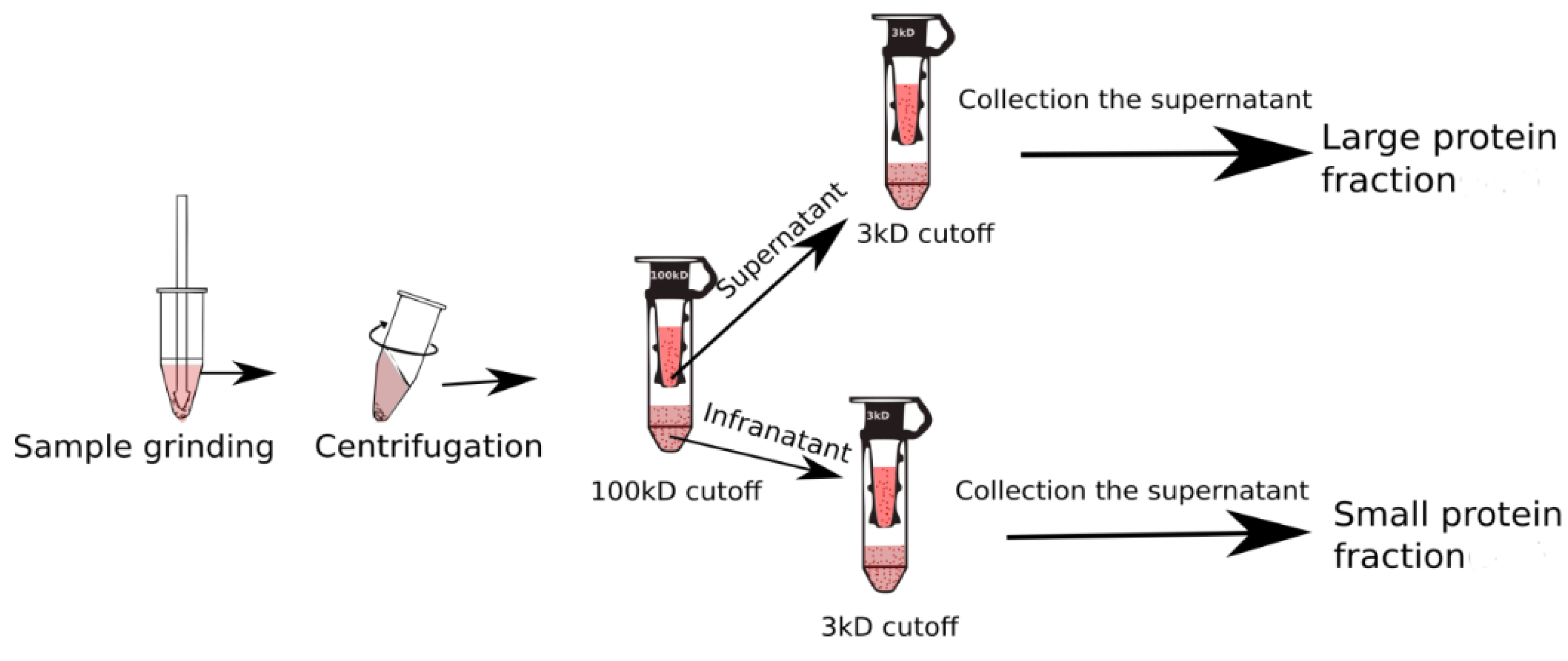
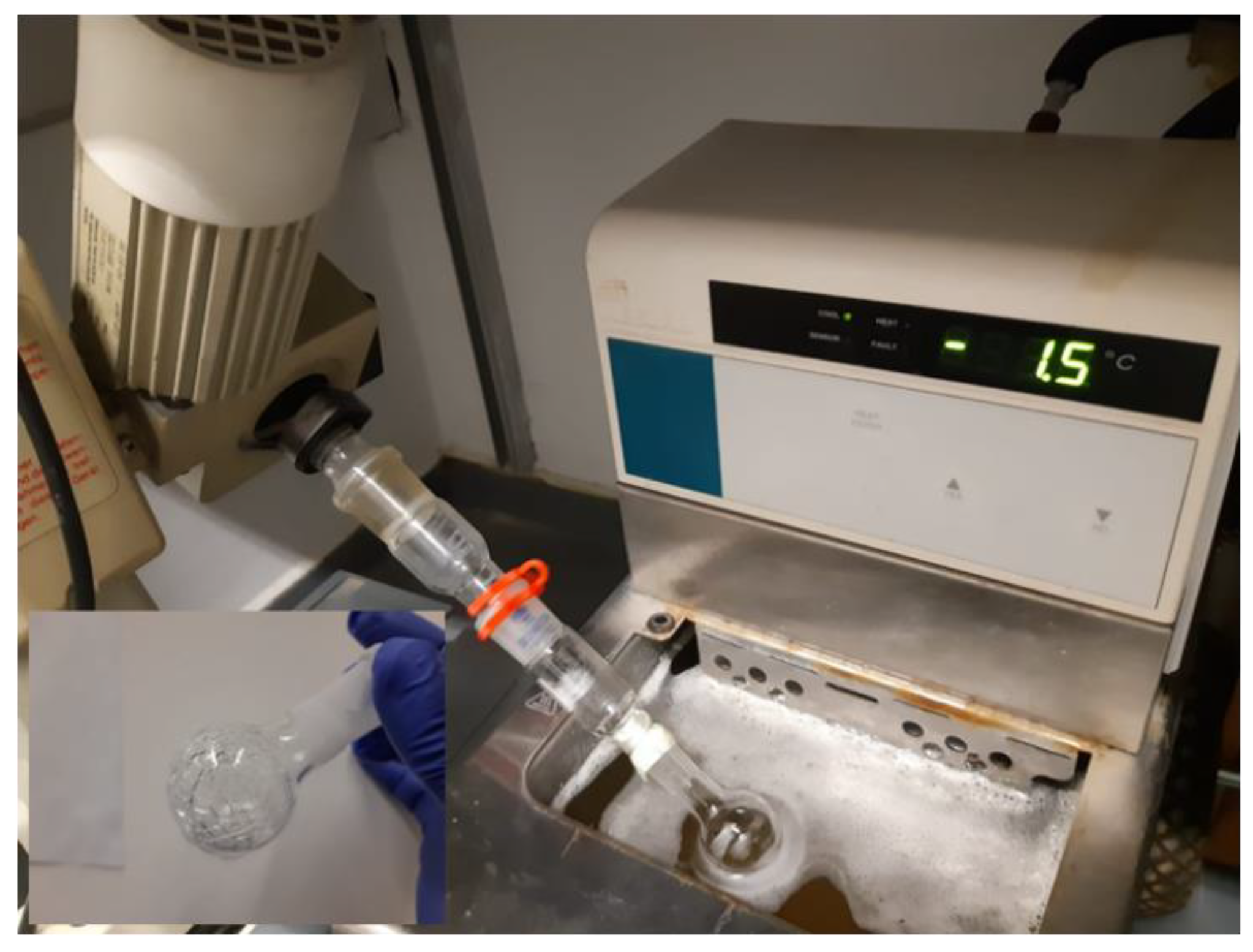
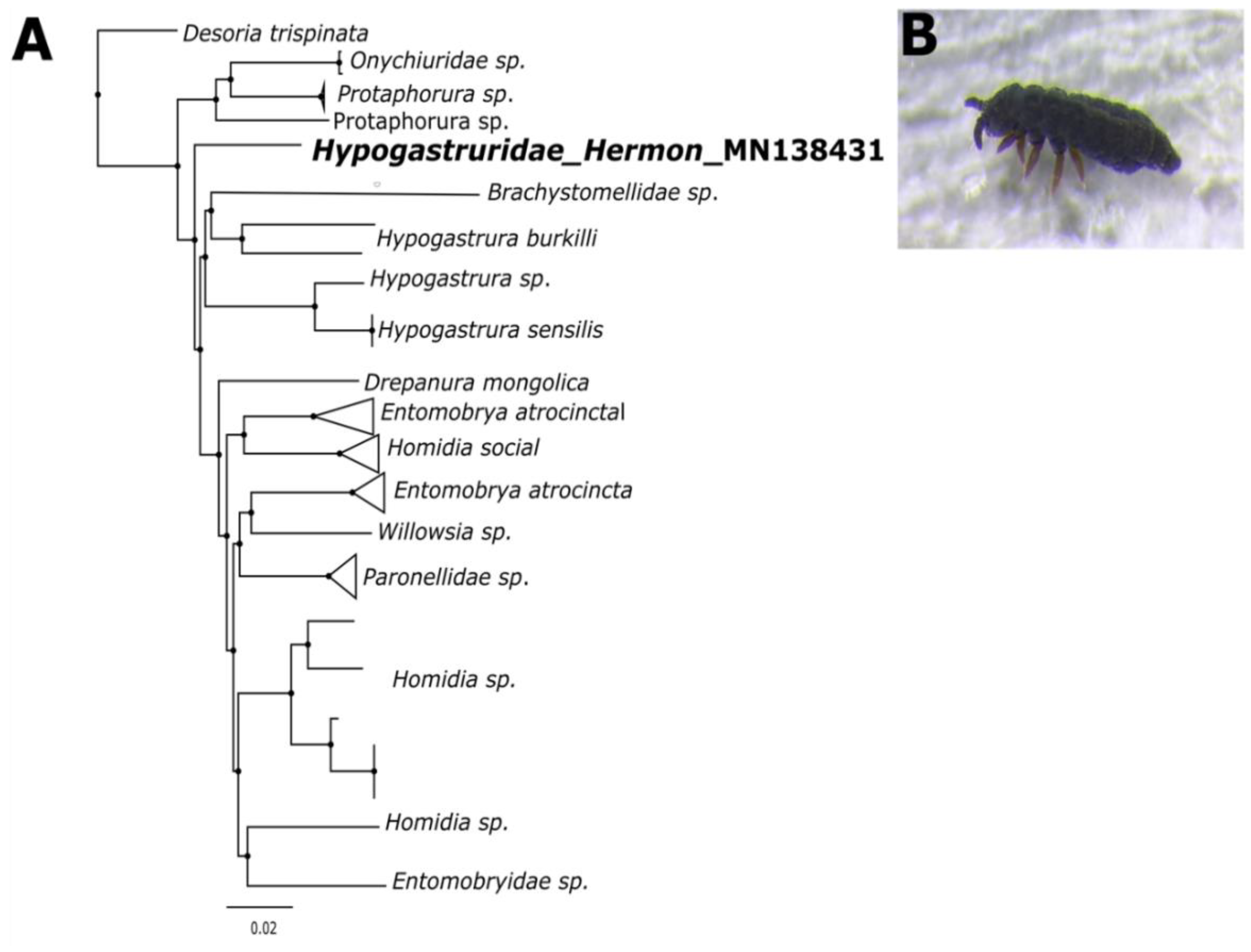
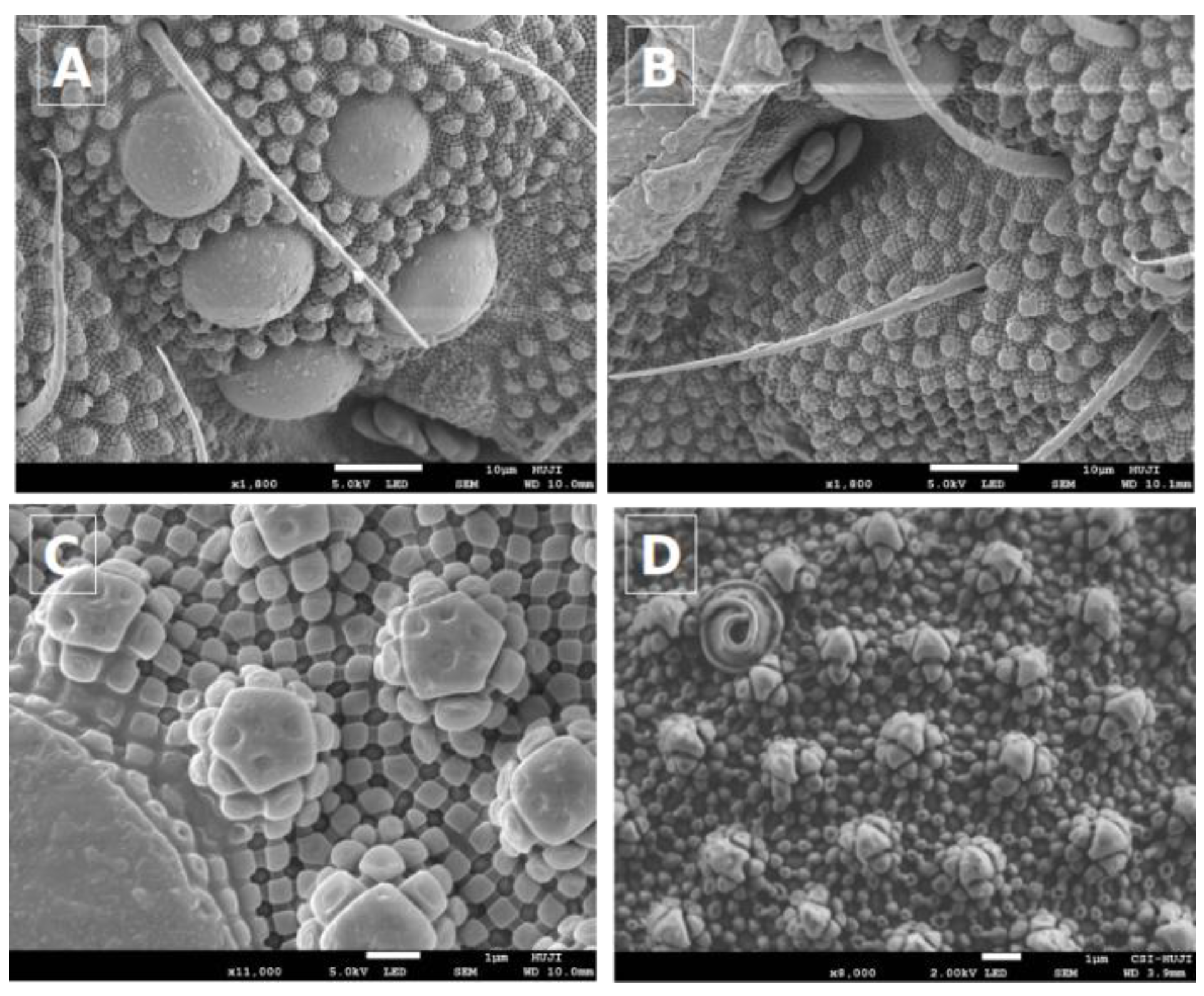

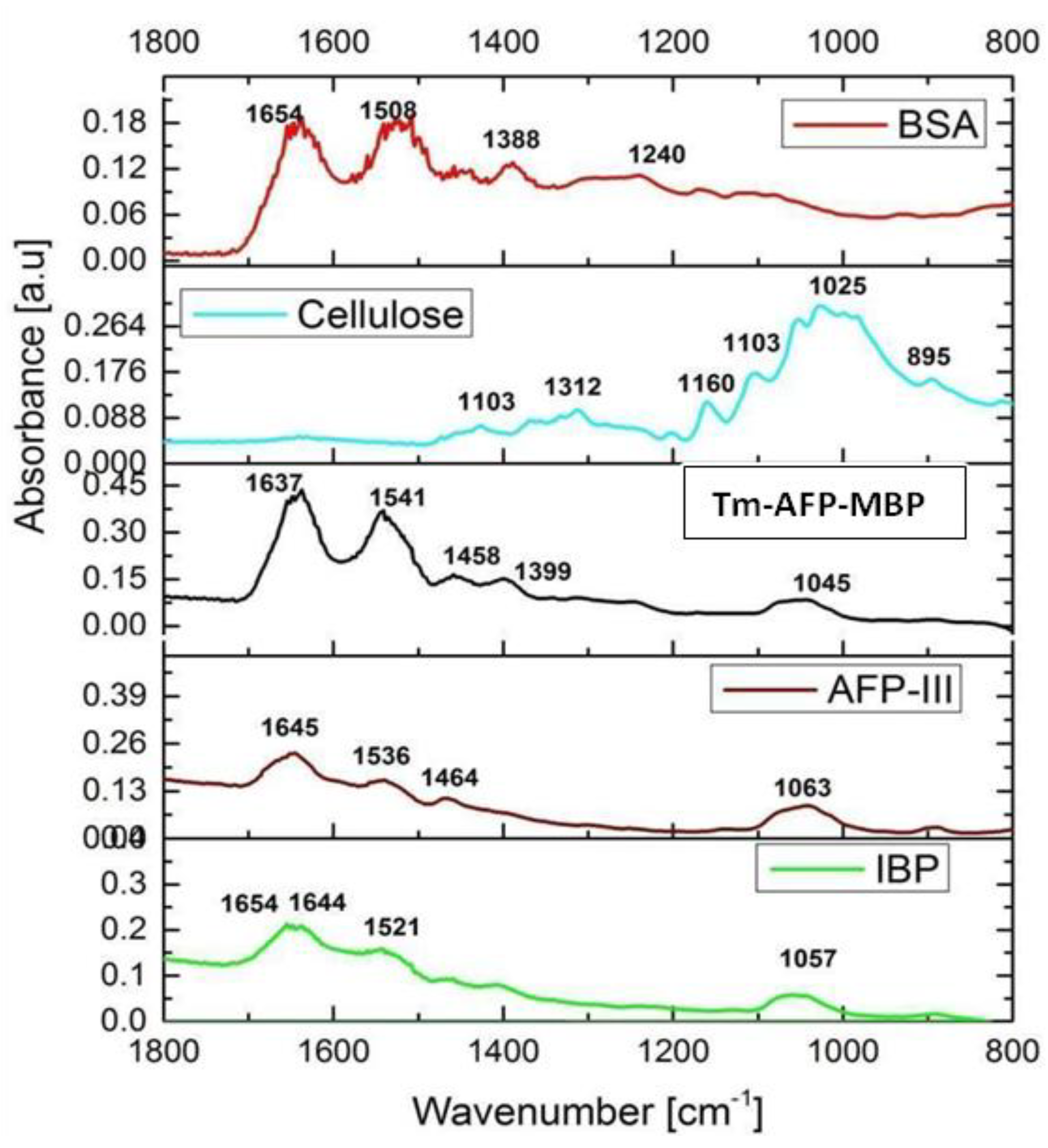
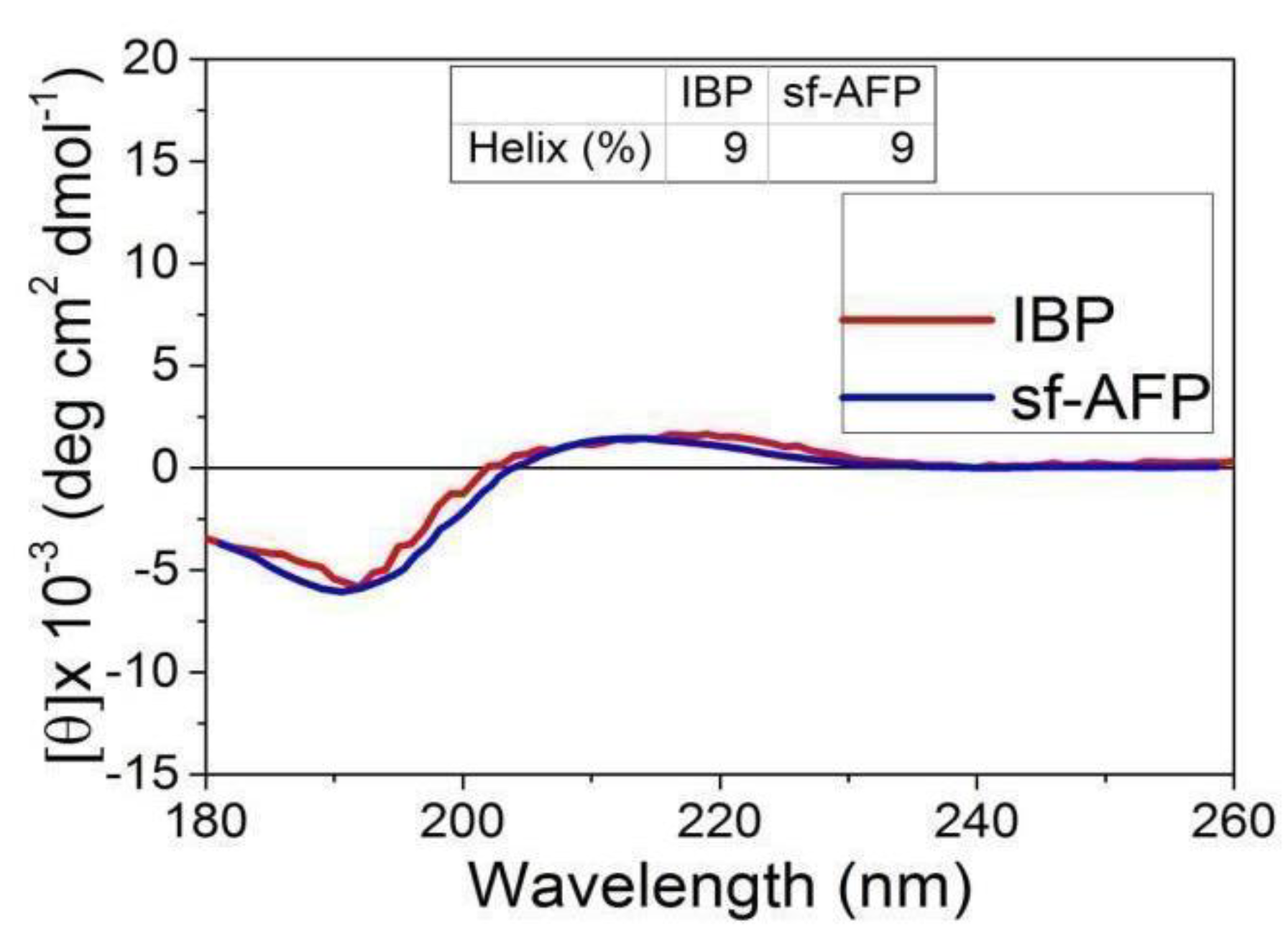
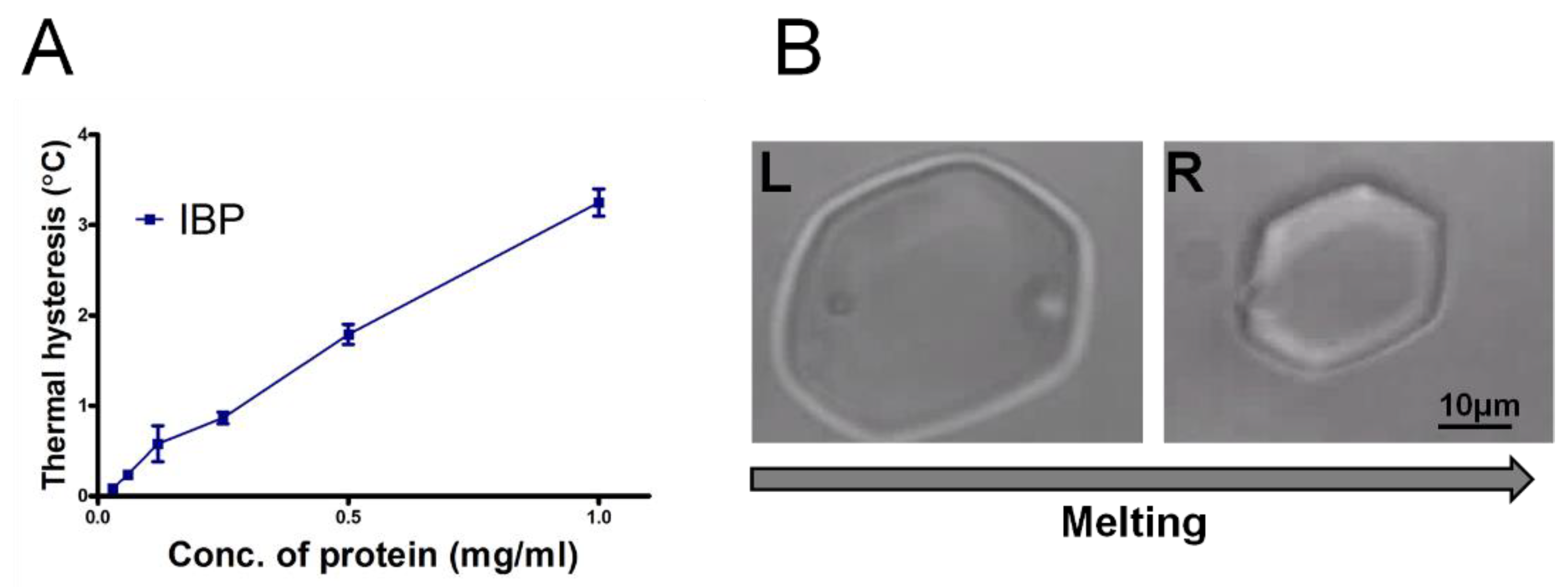

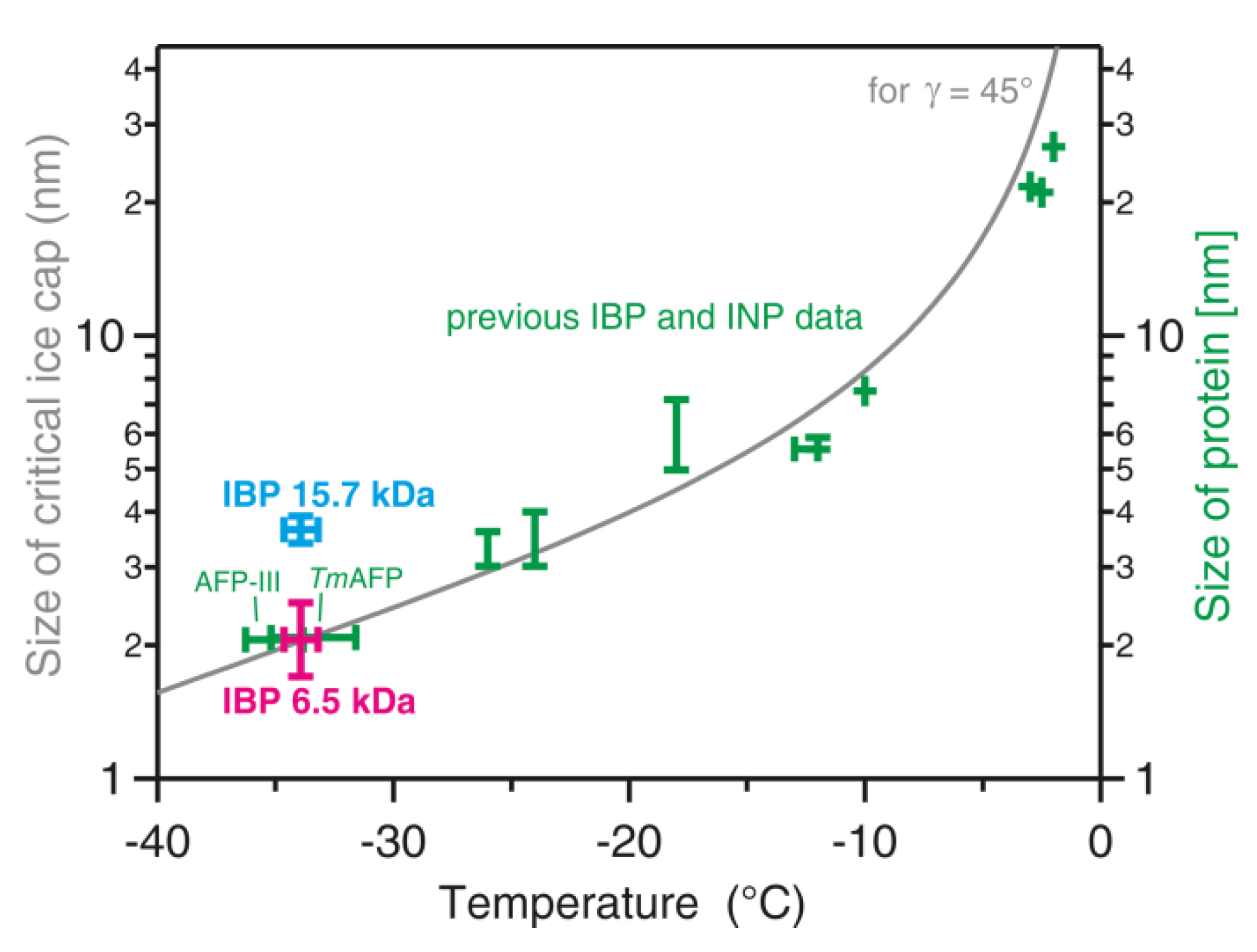
© 2019 by the authors. Licensee MDPI, Basel, Switzerland. This article is an open access article distributed under the terms and conditions of the Creative Commons Attribution (CC BY) license (http://creativecommons.org/licenses/by/4.0/).
Share and Cite
Bissoyi, A.; Reicher, N.; Chasnitsky, M.; Arad, S.; Koop, T.; Rudich, Y.; Braslavsky, I. Ice Nucleation Properties of Ice-binding Proteins from Snow Fleas. Biomolecules 2019, 9, 532. https://doi.org/10.3390/biom9100532
Bissoyi A, Reicher N, Chasnitsky M, Arad S, Koop T, Rudich Y, Braslavsky I. Ice Nucleation Properties of Ice-binding Proteins from Snow Fleas. Biomolecules. 2019; 9(10):532. https://doi.org/10.3390/biom9100532
Chicago/Turabian StyleBissoyi, Akalabya, Naama Reicher, Michael Chasnitsky, Sivan Arad, Thomas Koop, Yinon Rudich, and Ido Braslavsky. 2019. "Ice Nucleation Properties of Ice-binding Proteins from Snow Fleas" Biomolecules 9, no. 10: 532. https://doi.org/10.3390/biom9100532
APA StyleBissoyi, A., Reicher, N., Chasnitsky, M., Arad, S., Koop, T., Rudich, Y., & Braslavsky, I. (2019). Ice Nucleation Properties of Ice-binding Proteins from Snow Fleas. Biomolecules, 9(10), 532. https://doi.org/10.3390/biom9100532




